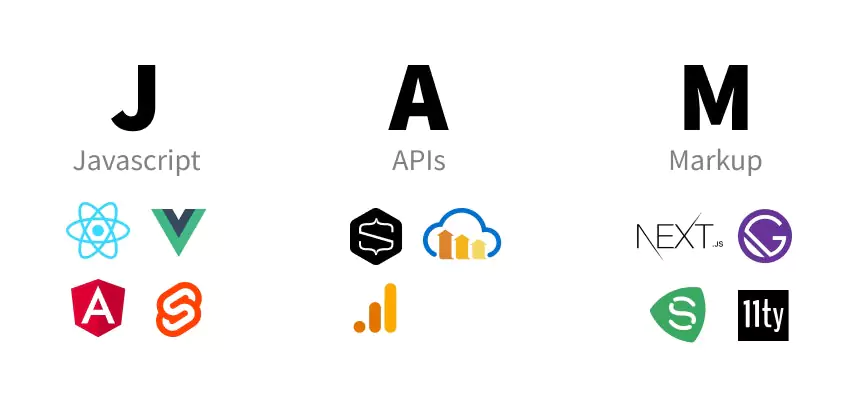New technologies and user behaviors are reshaping how websites and applications are built and used. Staying ahead in web development requires keeping up with the latest trends and technologies.
As we move through 2025, understanding these trends is crucial for delivering exceptional user experiences, ensuring robust security, and maintaining top-notch performance. This article will explore the top web development trends, looking at what they exactly are, why they matter, and how they can be used to create better online experiences.
>> Read more:
- Top Mobile App Development Trends
- Top Reasons Why Web Development Is So Important
- Top 13 Most Popular Web Development Frameworks
AI and Machine Learning Integration
Artificial intelligence (AI) and machine learning (ML) are quickly transforming web development by constructing intelligent systems that can learn from data, make informed decisions, and take action.
This powerful combination drives advancements in areas like predictive analytics, natural language ing, image and speech recognition, automation, and personalization, leading to more autonomous and adaptive solutions across various industries.
The integration of these technologies is becoming a trend due to its potential to revolutionize how websites function and interact with users. Businesses that embrace the power of AI can gain major benefits:
- Enhanced Customer Experience: Deliver personalized recommendations, improve customer support with chatbots, and create more engaging interactions.
- Increased Efficiency: Automate repetitive tasks, optimize es, and make data-driven decisions.
- Competitive Advantage: Gain insights into market trends, customer preferences, and competitor activities.
- Revenue Growth: Drive sales through targeted marketing campaigns and improved customer satisfaction.
>> Read more:
- Unlock the Power of Machine Learning as a Service (MLaaS)
- AI in Software Testing: How It Works, Benefits & Challenges
- The Four Key Principles of Responsible AI
- Will AI Replace Software Engineers Altogether?
How To Apply This Trend Technique To Your Web?
To apply AI and ML to your website, consider these strategies:
- Data Collection and Preparation: Gather relevant data about your users and website performance.
- Model Development and Training: Build and train AI and ML models to analyze data and identify patterns.
- Integration With Website: Incorporate AI and ML capabilities into your website's functionalities.
- Continuous Improvement: Monitor model performance and refine it over time.
Example: Imagine visiting an e-commerce website that uses AI and ML to enhance your shopping experience. As you browse, the site analyzes your behavior, preferences, and past purchases in real time. AI algorithms then curate personalized product recommendations, display tailored promotions, and even adjust the site's layout to highlight items you are most likely to be interested in.
This level of personalization not only improves user satisfaction but also boosts conversion rates and sales. By integrating AI and ML, the e-commerce site offers a seamless, intuitive, and engaging shopping journey, setting itself apart from competitors.

>> Read more:
- Top 5 Best Generative AI Tools
- Top 7 Machine Learning Solutions For Growing Your Business
- Top 9 Machine Learning Platforms for Developers
- Top 9 Best Deep Learning Frameworks for All Levels Developers
Progressive Web Apps (PWAs)
A Progressive Web App (PWA) is a web application developed with web technologies that provides a native app-like experience. PWAs have gained significant traction in custom web development for several reasons. They offer a superior user experience with fast loading times, offline functionality, and push notifications, which are features typically associated with native apps.
Additionally, PWAs are cost-effective to develop and maintain compared to native apps, as they require a single codebase for multiple platforms. The ability to be discovered through search engines also gives PWAs a wider reach than traditional apps.
PWAs have gained popularity in web development for business for a variety of reasons.
- Increased Engagement: PWAs can boost user retention and engagement rates.
- Cost Savings: Reduced development and maintenance costs compared to native apps.
- Wider Reach: PWAs can be accessed on various devices without requiring app store approval.
- Better SEO: Fast loading times and mobile-friendliness can improve search engine rankings for businesses.
How To Apply This Trend Technique To Your Web?
To transform your website into a PWA, you'll need to implement the following key components:
- Service Worker: This script enables offline functionality, push notifications, and background tasks.
- Manifest File: This JSON file provides metadata about your app, such as name, icons, and start URL.
- Responsive Design: Ensure your website adapts to different screen sizes and devices.
- Security: Implement HTTPS to protect user data.
- App-like Experience: Consider adding features like full-screen mode and app installation prompts.
Example: A leading e-commerce platform implemented a PWA to improve user experience. As a result, they saw a significant increase in page load speed, user engagement, and conversion rates. Users could browse products offline, receive personalized push notifications, and quickly access the app from their home screen, leading to a more satisfying shopping experience.
>> Read more: Strategies for Success in Mobile App Development
Responsive Web Design
Responsive design is a web design approach that makes websites adaptable to different screen sizes and devices, ensuring optimal viewing and interaction across desktops, tablets, and smartphones. The goal is to create a seamless user experience regardless of the device being used.
Responsive design has become an indispensable trend in web development due to the increasing diversity of devices accessing the internet. As more people browse on mobile devices, it is critical to create a mobile-friendly experience. Responsive design guarantees that websites are accessible and usable across all platforms, resulting in increased user satisfaction and engagement.
How To Apply This Trend Technique To Your Web?
To implement responsive design on your website, you'll need to use a combination of HTML, CSS, and JavaScript. Key techniques include:
- Fluid Grids: Layouts that can adjust to different screen sizes.
- Flexible Images: Images that can resize proportionally to the screen.
- Media Queries: CSS rules that apply based on specific screen sizes.
- Testing Across Devices: Ensuring your website functions correctly on various devices and screen resolutions.
Example: An online fashion retailer can implement responsive design to ensure a seamless shopping experience across devices. The desktop version might showcase multiple product images and detailed descriptions, while the mobile version prioritizes clear product images, pricing, and a simplified checkout . The website's layout adjusts automatically to different screen sizes, allowing customers to easily browse and purchase products on their preferred devices.
>> Read more: How To Choose The Best Responsive Website Builder Tool?
Jamstack
Jamstack is a modern architecture for building websites and applications that delivers fast performance and security. It combines pre-rendered static HTML files (markup), client-side JavaScript, and reusable APIs to create a dynamic web experience.
Jamstack has gained popularity due to its numerous advantages:
- Exceptional Performance: Faster load times for improved user experience.
- Enhanced Security: Fewer moving parts reduce security risks.
- Superior Scalability: Handles increased traffic without performance issues.
- Significant Cost Savings: Reduced infrastructure and maintenance costs.
- Streamlined Development: Focus on building features, not managing servers.
How To Apply Jamstack To Your Web Project?
To apply Jamstack to your web project, follow these steps:
- Choose a Static Site Generator: Select a tool like Gatsby, Next.js, or Hugo to create pre-rendered HTML files.
- Develop Your Front End: Build your website's user interface using HTML, CSS, and JavaScript.
- Integrate APIs: Connect your front end to external APIs to fetch dynamic data.
- Deploy to a CDN: Distribute your static files across multiple servers for fast delivery.
- Implement Serverless Functions: Use serverless functions for complex logic or dynamic content that cannot be pre-rendered.

Cybersecurity
Cybersecurity is the practice of protecting computer systems, networks, and data from digital attacks. In the context of web development, it involves safeguarding websites and applications from cyber threats.
Cybersecurity is essential due to the increasing sophistication of cyberattacks and the growing reliance on digital platforms. Data breaches, identity theft, and financial loss can severely damage a business's reputation and bottom line.
For businesses, robust cybersecurity is crucial to protect sensitive customer data, maintain trust, and comply with regulations. A strong security posture can prevent financial losses, legal liabilities, and reputational damage.
How To Apply This Trend Technique To Your Web?
To enhance your website's security, implement the following measures:
- Secure Coding Practices: Write code with security in mind, preventing vulnerabilities like SQL injection and cross-site scripting (XSS).
- Data Encryption: Protect sensitive data by encrypting it both in transit and at rest.
- Strong Authentication: Implement robust authentication methods, such as multi-factor authentication (MFA).
- Regular Security Updates: Keep software and systems up-to-date with the latest security patches.
- Security Testing: Conduct regular vulnerability assessments and penetration testing.
- Incident Response Plan: Develop a plan to respond to security breaches effectively.
- User Education: Train employees and users about cybersecurity best practices.
Cloud Computing
Cloud computing is the delivery of IT services, such as computing power, storage, and databases, over the Internet. Instead of owning and maintaining physical data centers and servers, you can access these services from a cloud provider as needed.
Cloud computing is crucial in web development due to its flexibility, scalability, and cost-effectiveness. It allows developers to focus on application development rather than infrastructure management, resulting in faster development cycles and lower operational costs.
For businesses, it offers numerous benefits, including:
- Cost savings: Pay-per-use model eliminates upfront hardware investments.
- Scalability: Easily adjust resources based on demand.
- Improved Performance: Access high-performance computing resources.
- Disaster Recovery: Cloud-based backups and redundancy enhance data protection.
- Collaboration: Facilitate teamwork and access data from anywhere.
How To Apply This Trend Technique To Your Web?
To incorporate cloud computing into the web development, consider these steps:
- Choose a Cloud Provider: Select a suitable cloud platform (e.g., AWS, Azure, GCP).
- Utilize Cloud Services: Leverage cloud-based infrastructure, storage, databases, and other services.
- Implement Serverless Architecture: Consider using serverless functions for specific tasks.
- Optimize for Cloud Performance: Design your application to take advantage of cloud capabilities.
- Security: Prioritize data security and compliance with cloud security best practices.
Serverless Architecture
Serverless architecture is a cloud computing model in which the cloud provider constantly allocates the machine resources to run application code. The serverless architecture has grown in popularity due to its potential to dramatically minimize operational overhead and improve scalability.
By eliminating the need to manage infrastructure, developers can concentrate only on writing code, resulting in a shorter development cycle and higher productivity. Furthermore, serverless functions scale automatically to suit changing workloads, ensuring peak performance and cost-effectiveness.
For businesses, serverless architecture offers several advantages:
- Cost-efficiency: Pay only for the actual compute time used, eliminating idle server costs.
- Scalability: Automatically adjusts to handle varying workloads, ensuring optimal performance.
- Developer Productivity: Focus on core business logic without infrastructure management.
- Time-to-market: Accelerates development and deployment cycles.
How To Apply This Trend Technique To Your Web?
To apply serverless architecture to your web application, consider the following:
- Identify Suitable Functions: Break down your application into independent, executable functions.
- Choose A Serverless Platform: Select a cloud provider that offers serverless computing services (e.g., AWS Lambda, Azure Functions, Google Cloud Functions).
- Optimize Function Code: Write efficient and concise code to minimize execution time and costs.
- Leverage Serverless Databases: Utilize serverless database services for data storage and retrieval.
- Implement Error Handling and Monitoring: Monitor function performance and implement robust error handling.
- Consider Security: Implement appropriate security measures to protect your functions and data.
>> Read more:
- Top 7 Web App Security Testing Tools For Developers
- Top 14 Best Data Security Software For Your Businesses
Voice Search Optimization
Voice search optimization is the of optimizing your website to appear in search results when users conduct voice searches using virtual assistants like Siri, Google Assistant, or Alexa.
The increasing popularity of voice assistants and smart speakers has made voice search a significant trend in web development. People are finding it more convenient to use voice commands for searches, dictating their queries rather than typing them.
By optimizing voice search, your business can increase visibility, attract higher traffic, and improve customer experience. Understanding how people speak and search can better cater to their needs and capture a larger audience.
How To Apply This Trend Technique To Your Web?
To optimize your website for voice search:
- Focus On Natural Language: Use conversational language in your content to match how people speak.
- Target Long-tail Keywords: Incorporate longer, more specific keywords and phrases that reflect natural speech patterns.
- Create Informative Content: Provide clear and concise answers to potential voice search queries.
- Optimize For Featured Snippets: Aim to have your content appear as a featured snippet in search results.
- Local SEO: Optimize your local business listing for voice searches.
- Schema Markup: Implement schema markup to help search engines understand your content.
Example: A local Italian restaurant can optimize its website for voice search by focusing on conversational language and long-tail keywords. By incorporating phrases like "best Italian restaurant near me," "where to find authentic Italian food," or "romantic Italian dinner," the restaurant can increase its chances of appearing in voice search results. Additionally, providing detailed information about the restaurant's location, cuisine, and atmosphere can improve its local SEO and attract customers searching for specific dining experiences.

API Development
API development is a design technique that prioritizes creating a well-defined API before developing an application's frontend or backend components. Essentially, the API is the cornerstone of the entire project.
The API-first method has gained popularity due to its multiple advantages. By focusing on the API first, development teams may create a clear contract for how different elements of the system will interact, resulting in increased collaboration and efficiency. It also supports reusability, as the API can be used by multiple apps and platforms.
Furthermore, API-first development offers several advantages for businesses:
- Accelerated Development: By having a well-defined API, development teams can work independently on different parts of the application simultaneously.
- Increased Flexibility: APIs can be easily integrated with other systems and services, enabling rapid innovation.
- Improved Scalability: APIs can handle increased traffic and growth more effectively.
- Enhanced Developer Experience: Clear API documentation and standardized interfaces make it easier for developers to work on the project.
- Potential For New Revenue Streams: APIs can be monetized through partnerships or by offering them as a product.
How To Apply This Trend Technique To Your Web?
To implement an API-first approach, follow these steps:
- Define API Requirements: Clearly outline the API's purpose, target audience, and functionalities.
- Design the API: Create a detailed API specification using tools like OpenAPI (Swagger).
- Develop the API: Build the API backend and implement the defined endpoints.
- Test and Document the API: Thoroughly test the API and provide comprehensive documentation.
- Consume the API: Develop frontend and backend applications that consume the API.
Example: An online clothing retailer might integrate a weather API to enhance the user experience. By accessing real-time weather data, the website can dynamically suggest products based on the user's location and current weather conditions.
For instance, if the weather forecast predicts rain, the website could prominently display raincoats, umbrellas, and boots. This personalized approach improves customer engagement and increases the likelihood of purchases. Additionally, the API could be used to provide localized product recommendations, such as suggesting lightweight summer clothing for users in warm climates.
>> Read more:
- Mastering Axios in React.js for Effective API Management
- Fetch API vs Axios: Detailed Comparison in Practical Scenarios
- gRPC vs GraphQL: Choosing the Right API Technology
- The Guideline To Become Skilled API Developer
Micro Frontend Development
Micro frontend development is an architectural approach to building web applications where the frontend is broken down into smaller, independently deployable units. These units, called micro frontends, can be developed, tested, and deployed independently.
Micro frontend development has become increasingly popular due to the growing complexity of web applications. As applications change, monolithic frontend architectures can be challenging to maintain and scale. Micro frontends address these challenges by enabling independent development, testing, and deployment of features.
For businesses, micro frontends offer several advantages:
- Increased Development Velocity: Teams can work independently on different features, accelerating development time.
- Improved Scalability: Each micro frontend can be scaled independently based on its specific needs.
- Technology Diversity: Different teams can use different technology stacks, fostering innovation.
- Reduced Risk: Issues in one micro frontend are less likely to impact the entire application.
- Better Team Autonomy: Teams can own and manage their micro frontends, increasing ownership and responsibility.
How To Apply This Trend Technique To Your Web?
To implement micro frontends, consider the following steps:
- Identify Micro Frontends: Break down your application into independent features or modules.
- Define Boundaries: Establish clear boundaries between micro frontends, including data sharing and communication mechanisms.
- Choose An Integration Strategy: Select a suitable approach for combining micro frontends, such as iframe, custom elements, or web components.
- Establish A Build and Deployment Pipeline: Create independent build and deployment es for each micro frontend.
- Manage Routing and Navigation: Implement a strategy for handling routing and navigation across multiple micro frontends.
Example: Consider an e-commerce platform that adopts micro frontend architecture. This e-commerce platform can benefit from micro frontend architecture by breaking down the site into independently developed modules like the product catalog, shopping cart, and user reviews.
Each module can use different technology stacks, accelerating development and allowing for independent scaling. This approach results in a more agile, scalable, and resilient platform, delivering a superior user experience.
VR & AR Development
The rapid advancement in hardware, such as VR headsets and AR-enabled devices, has driven a surge in VR and AR development. As technology becomes more accessible and affordable, businesses and consumers are increasingly interested in these immersive experiences.
While VR and AR are still emerging technologies, they hold immense potential to transform the way people interact with digital content. By investing in VR and AR development, businesses can gain numerous opportunities to engage with customers, enhance products, and create new revenue streams. These technologies can also be used for training, product visualization, marketing, gaming, and many other applications.
How To Apply This Trend Technique To Your Web?
To incorporate VR and AR into your web development strategy, consider the following:
- Identify Target Audience: Determine who will benefit most from a VR or AR experience.
- Define Goals: Clearly outline the objectives of your VR or AR project.
- Choose The Right Platform: Select suitable hardware and software for development.
- Design Immersive Experiences: Create engaging content that leverages the unique capabilities of VR and AR.
- Test and Iterate: Continuously refine your VR or AR experience based on user feedback.
Example: Travel websites are leveraging VR and AR to redefine the booking experience. By offering immersive virtual tours of destinations, travelers can explore potential vacation spots firsthand. Additionally, AR can enhance on-site experiences by providing interactive overlays with information and context. This combined approach creates a more engaging and informative journey for customers.

No-code or Low-code Development
No-code and low-code development refer to building web applications using visual interfaces and pre-built components, minimizing or eliminating the need for traditional coding. Low-code platforms allow for some custom coding, while no-code platforms are entirely code-free.
These approaches have become popular due to the increasing demand for rapid web application development. They reduce development time, lower costs, and allow businesses to focus on core competencies rather than IT infrastructure.
For businesses, no-code and low-code platforms offer several advantages:
- Accelerated Development: Rapidly build and deploy applications.
- Reduced Costs: Lower development and maintenance expenses.
- Increased Agility: Quickly adapt to changing market conditions.
- Citizen Development: Empower non-technical employees to build applications.
- Focus On Core Competencies: Allocate resources to strategic initiatives.
How To Apply This Trend Technique To Your Web?
To apply no-code or low-code development to your web projects, consider the following steps:
- Identify Suitable Projects: Assess which applications are good candidates for no-code or low-code development.
- Select Platform: Choose a platform that aligns with your project requirements and team skills.
- Design The Application: Use the platform's visual interface to design the application's user interface and workflow.
- Integrate Data: Connect the application to your existing data sources.
- Test and Deploy: Thoroughly test the application before deploying it to users.
>> Read more: How Does No-Code AI Assist In App Development?
Conclusion
The web development landscape is in a constant state of flux, driven by technological advancements and changing user expectations. Embracing the 12 web development trends outlined in this article can create innovative, engaging, and efficient web experiences. From AI-powered personalization to immersive VR and AR, staying informed and adapting to these trends is crucial for business success in the digital age. Remember, the key to success lies in leveraging these trends strategically and aligning them with your business objectives.
>>> Follow and Contact Relia Software for more information!
- web development
- Web application Development
- development

